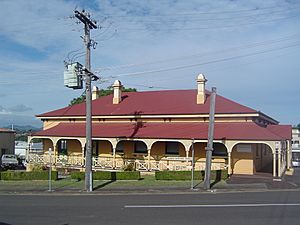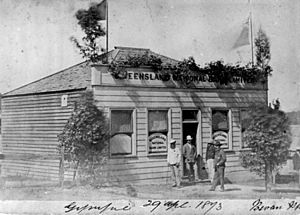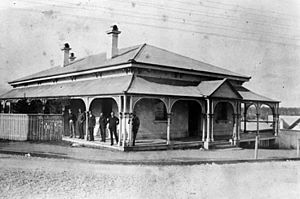Queensland National Bank, Gympie facts for kids
Quick facts for kids Queensland National Bank, Gymie |
|
|---|---|

Former Queensland National Bank, 2012
|
|
| Location | corner of Channon Street and Nash Streets, Gympie, Gympie Region, Queensland, Australia |
| Design period | 1870s - 1890s (late 19th century) |
| Built | 1876-1877 |
| Architect | John Richard Hall, Claude William Chambers |
| Official name: Queensland National Bank (former) | |
| Type | state heritage (built) |
| Designated | 15 April 2011 |
| Reference no. | 602773 |
| Significant period | 1877-1930s |
| Significant components | bank |
| Builders | Andrew Collins |
| Lua error in Module:Location_map at line 420: attempt to index field 'wikibase' (a nil value). | |
The Queensland National Bank building in Gympie is a historic site. It used to be a bank and later a town hall. You can find it at the corner of Channon Street and Nash Streets in Gympie, Queensland, Australia.
The building was designed by architects John Richard Hall and Claude William Chambers. It was built between 1876 and 1877 by Andrew Collins. This important building was added to the Queensland Heritage Register on April 15, 2011.
Contents
A Look Back: The Bank's History
This single-storey building, made of stone, used to be the Queensland National Bank (QNB) and a home for the bank manager. It stands on the corner of Channon and Nash Streets in Gympie. Architect John Richard Hall designed it in 1875, and it opened in February 1877. Later, in 1898, architect Claude Chambers designed some additions. The building served as a bank until 1937.
How Gold Shaped Gympie
Gympie, first called Nashville, started when gold was found in the Mary River area in October 1867. This discovery made Queensland a big gold producer. It also brought much-needed money to the young colony. Thousands of people came to the Gympie goldfield after the gold was found.
At first, people found gold easily near the surface. But by 1875, miners had to dig deeper. This deep mining needed a lot of money to buy equipment and pay workers. In 1881, the mines started producing huge amounts of gold. This began a new time of wealth for Gympie.
As Gympie grew, it developed a unique look. Its streets followed the hills and valleys. Many roads, like Channon Street, run along the tops of ridges. Nash Street connects across valleys and hillsides. Over time, the early temporary buildings were replaced. More permanent buildings, like government offices on Channon Street, appeared from the mid-1870s.
Fires in Mary Street in 1877, 1881, 1891, 1929, and 1946 destroyed many old buildings. However, the QNB building was not damaged. Other old buildings still standing include the former Gympie Court House and Lands Office (1876) and the first Masonic Hall (1869).
The Queensland National Bank's Story
The Queensland National Bank was the first and most successful bank started in Queensland in the 1800s. It became the most powerful bank in the colony. Important Queensland leaders, politicians, and business people started it in March 1872. They wanted to control their own money for development.
The bank started trading on June 3, 1872, in Brisbane. Many people in Queensland chose to bank with QNB. New branches opened quickly. By early 1874, the bank had 10 branches. In 1878, a London branch opened, followed by a Sydney branch two years later.
In 1879, Thomas McIlwraith, who was Queensland's Premier, convinced the Queensland Parliament to give the QNB all of the government's banking business. By 1880, the QNB held 40% of all deposits and loans in Queensland. This was more than any other bank in any Australian colony. Even with some financial problems later, the bank handled the government's money for 42 years, until 1921.
QNB in Gympie: A Gold Rush Hub
A Queensland National Bank branch opened in Gympie on December 11, 1872. This was less than six months after the bank first started. In its first 21 days, the Gympie branch bought 6,095 ounces of gold. In its first seven years, it handled 142,000 ounces of gold!
By 1890, the QNB had 14 branches in Queensland's mining areas. Gympie and Charters Towers were the most important mining branches. They handled more than half of the bank's mining business. Their total deposits and loans were over £500,000, making them very profitable.
Gold production from Gympie, Charters Towers, and Mount Morgan was very important for Queensland. During the 1880s and 1890s, gold made up between 21% and 35% of Queensland's export income. The value of gold went from £698,000 in 1883 to £2.75 million in 1889. This was more than the value of exported wool. Banks like the Queensland National Bank played a key role in buying and distributing this huge amount of gold.
The Architects Behind the Bank
John Richard Hall (1835-1883) was the architect for the Gympie QNB branch and many others. He was born and trained in England. He came to Australia by 1857. Hall started his own architecture business in Brisbane in 1864. He designed many beautiful buildings across Queensland. These included buildings for the Queensland National Bank, schools, homes, and churches.
Hall designed the Gympie bank building in 1875. Construction began the next year. The new building was built on the site of the bank's old timber building. The old building was moved to the back and used as part of the manager's home.
Local Gympie architect Hugo Durietz oversaw the building of the QNB branch. The new building was mainly brick with stone foundations. Andrew Collins was chosen as the builder, with his bid of £1,500. The total cost of the building, which opened in February 1877, was £2,495.
In 1898, Claude William Chambers (1861-1947) made changes to the Gympie QNB building. These changes made the bank wider on the western side of the Channon Street entrance. This allowed for more space for the accountant, clerks, and a strong room. Chambers was a well-known architect in Brisbane. His major works include "Drysllwyn" (later 'Raymont Lodge') and "Ross Roy".
From Bank to Council Chambers
After 1900, Gympie's main purpose changed from gold mining to serving the surrounding dairy and fruit farms. So, the QNB focused on business from farming. The town's business center also moved eastward down Mary Street, closer to the railway station.
In 1937, the QNB bought new premises at the corner of Mary and Monkland Streets. The Channon Street bank building was sold the next year. It was then used by industrial businesses until the Widgee Shire Council bought it in 1990.
The Widgee Shire Council restored the building in 2000. They received money for the project. The work included putting back the front and side verandahs, which had been removed years before. They also repaired the roof, floors, windows, and plumbing. The building was painted inside and out.
The building then served as the Widgee Shire Council chambers. Later, it became the Cooloola Shire Council chambers. After the shires joined to form the Gympie Region in 2008, the building was used as office space by the Gympie Regional Council.
What the Building Looks Like
The former Queensland National Bank is a single-storey building made of rendered stone. It stands on the corner of Channon and Nash Streets in Gympie.
The building has a hipped roof covered with corrugated metal. Because the ground slopes, the building is supported by concrete stumps and stone walls on the lower side. Three stone chimneys rise from rooms on the eastern side. Decorative timber brackets and concrete designs run along the building under the main roof. A rebuilt timber verandah goes around the northeast and northwest sides. It has a curved roof also covered with corrugated metal.
The main front of the building faces Channon Street. It has a projecting gable roof entrance within the curved verandah roof. There are large sash windows on either side of the main entrance. The entrance itself is a two-leaf timber door with an arched window above it. Simple concrete sills are under the windows.
The side facing Nash Street has a row of openings. These include French windows and an entrance to the former manager's home. There are also four large sash windows like those on the main front. The back of the building has a small, newer extension with a porch and toilets. The southeast side has two large sash windows and is supported by a stone wall.
Inside, the building is shaped like an "L". The bank part is in the northwest wing, and the manager's home is in the southeast wing. The bank area has the main banking room, an office for the accountant and clerks, a strong room, a manager's office, and a stationery room.
When you enter from Channon Street, you step into the banking room. It has a decorative pressed metal ceiling and a fancy border. Two arched openings lead to the accountant and clerks' area, which also has a matching pressed metal ceiling. A strong room with a heavy metal door is in this area.
The former manager's office is in the northern corner of the building. It connects to the banking room and the stationery room. The stationery room then opens to the former residence. The manager's office has a beautiful pressed metal ceiling and a fireplace with a decorative timber frame.
The manager's home part is square-shaped. Four rooms are off a central hallway. The main entrance to Nash Street is a four-panel timber door with side windows and a window above. Both front rooms have fireplaces with carved timber frames. The ceilings in the home are plain plaster. Some original features like skirting boards, door frames, and window frames are still there. The floors are pine, some polished and some covered with carpet.
A paved car park is to the southwest and southeast of the building. A shed to the south-east is not considered historically important.
Why This Place is Important
The former Queensland National Bank building was added to the Queensland Heritage Register on April 15, 2011. This means it is a special historical place.
Showing Queensland's History
This building (built 1877) shows how important banks were during Queensland's gold rush. It helped turn huge amounts of gold into cash. Gympie's gold brought a lot of wealth to Queensland for about 60 years, starting in 1867.
This QNB building is special because it was one of the first permanent business buildings built after the early success of gold mining in Gympie. It shows how people expected more gold to be found. For 60 years, it was a Queensland National Bank branch and the manager's home. It is one of the few known commercial buildings from the 1870s left in Gympie.
The bank's location on Commissioners Hill, and its later sale when the town center moved, also show how Gympie developed over time.
What Makes It Special
The former QNB building is a great example of a regional bank from its time. It's a stone building that combined a banking room, offices, and a manager's home. Its location, near other important government buildings like the Lands Office and Courthouse, shows how important banks were in the gold mining town of Gympie.
It is the oldest bank building still standing in Gympie and the only one from the 1870s. Its original layout, room sizes, wooden details, strong room, and pressed metal ceilings are still mostly intact.
Its Beautiful Design
Located on one of Gympie's high points, near important government buildings, the former QNB building shows how important and lasting the bank was in one of Queensland's most economically important towns. Along with other bank buildings, like the former Bank of New South Wales, the QNB building helps create an important and well-preserved gold-era area in Gympie.
The building is beautiful because of its architectural design. You can see the skill in the craftsmanship and details of the wood and finishes. Its shape, size, and design also make the streetscape look good, fitting in with other 19th-century buildings nearby.
Connected to Important People and Groups
The former QNB building was a QNB branch from February 1877 until 1937. It has a special connection to the Queensland National Bank. As one of its earliest and most profitable branches, the Gympie branch was very important to the QNB's growth in Queensland. By 1880, the QNB held 40% of all deposits and loans in Queensland. The bank also handled the Queensland government's money for 42 years (1879-1921). As the most powerful bank in the colony, the QNB was a major force in Queensland's economy in the late 1800s.
Images for kids





